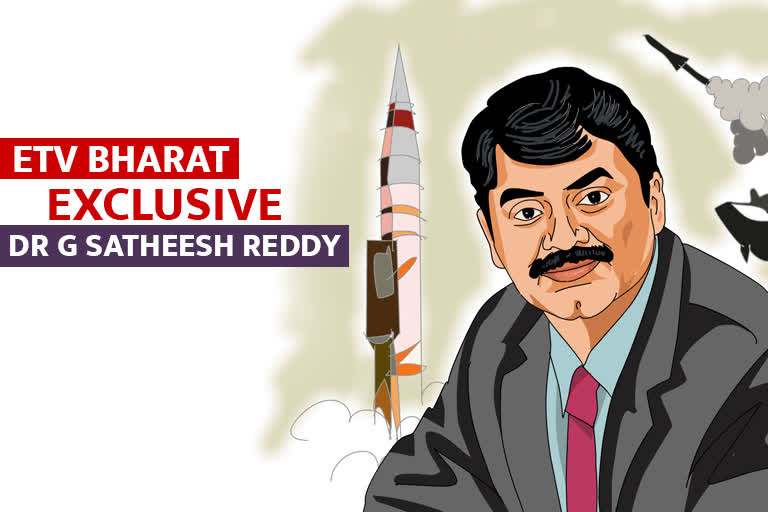Lucknow: As per SIPRI (Stockholm International Peace Research Centre) database, India was one of the world’s largest arms importer for several years in a row in the last decade.
The country still imports defence equipment worth $18-20 billion a year.
The government is trying to change the situation in the defence sector through its ‘Make in India’ initiative.
The focus of the government is on design, development and manufacture of weapons in the country with greater participation of private-sector defence manufacturers.
In an exclusive interaction with ETV Bharat’s Krishnanand Tripathi, Chairman of Defence Research and Development Organisation (DRDO), Dr G Satheesh Reddy said the country will achieve 75% indigenisation in the next 5-10 years.
DRDO is India’s apex defence research establishment. The interaction took place on the side lines of DefExpo India 2020.
ETV BHARAT: What is your organisation’s plan for strengthening the defence sector in the country?
G SATHEESH REDDY: Firstly, today we are close to 40-50% content indigenisation in the armed forces and this has to go up beyond 75%, that is what hon’ble Pradhan Mantri Ji has said. And we also need to improve our exports. In fact, we need a lot of exports. He has given a target of $5 billion in the coming years. DRDO being the frontier research and development organisation, we need to plan what all are the technologies that we need to develop. What all are the systems that we need to develop.
Today, in many areas, we have become very strong capability wise. We are very strong in missiles, radars, sonars, torpedoes, electronic warfare systems and guns. We want to make a variety of systems in these areas and ensure that there are no imports in these areas. So this is one of the ways by which we can reduce the imports. Also, we can think of exporting in these areas.
So then there are other technologies like we have communication systems, jamming systems, our SDRs and our life sciences related aspects. We have bulletproof jackets, shoes and many other things.
ETV BHARAT: Last year, India imported defence equipment worth $18-20 billion. By when the country would be able to reduce these imports by half?
G SATHEESH REDDY: I am saying that in the next 5-10 years our indigenous content will definitely go up to 75%.
ETV BHARAT: Second thing, we see a lot of duplication, in case of Akash missile developed by DRDO, the user went ahead with Spyder missile system developed by Israel’s Rafael Industries that use Derby and Python rockets, though both of them have a similar range. Same is the case with Spike missile, the army didn’t by Helina anti-tank missiles.
G SATHEESH REDDY: The application of various varieties of missiles and technologies are different, based on that people buy which can be used, which can be mobile, which can be used for what range and applications and all that. So, there is a definite clear cut plan among the services: what all are the weapons that they have, what all are the weapons that they should deploy and what all are the weapons that they should be inducting in what phases and all that. So somewhere, some phasing out of some weapon will also be there, some weapons will be inducted and there will be longing for some other weapon systems. So there is a clear cut plan with which they go.
Read more:RBI survey shows worsening confidence in economy
So we cannot combine Akash and Derby, they are different class. But look at the indigenous content, Akash missiles worth Rs 25,000 crores have been purchased.
There has been a stress and definite importance given to the indigenous content in a big way. And the portion of indigenous content will be going up in the coming years and armed forces are pushing for indigenous systems in a big way.
ETV BHARAT: When we speak to the industry people, they say that though they are getting into collaboration with foreign players but IPRs (Intellectual Property Rights) are not shared with them. In fact, when the country used to import weapons, tons and tons of papers came to India but the real reasoning for selecting or abandoning a particular design was never given to India. How do you propose to bridge this gap?
G SATHEESH REDDY: The point is that whenever you are trying to get technology from abroad and if it is the latest technology then it is always very clear that they will not give complete knowledge to you. That is why any country which has developed a technology, it has developed the technology within the country.
So we need to develop. That is what DRDO is trying to do today. So all the technologies that DRDO is developing is completely indigenous and the technology that is coming from outside is just manufacturing technology.
Naturally, wherever you have the technology, you use the in house technology. And those things, where you don’t have the technology, you use a technology which is a manufacturing technology also, you have to live with that.
ETV BHARAT: Do your policies permit you to share your Intellectual Property Rights (IPR) with the private sector so that their capacities can also be built?
G SATHEESH REDDY: You have already seen that we already made all our patents open with the Indian industry so that they can use. And we have made it available for the growth of the Industry.



